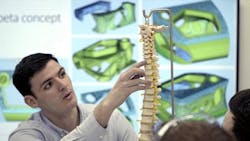3D Printing Shows Capabilities for Spinal Implants
Renishaw, a precision engineering and manufacturing technologies company, has collaborated with two advanced technology firms to demonstrate the advantages of additive manufacturing (AM) in the production of spinal implants. By working with Irish Manufacturing Research (IMR) and nTopology, the project shows how streamlined the transition from design to AM can be when working with the right partners.
IMR designed a sample titanium spinal implant, aimed at the cervical spine (c spine), using nTopology’s generative design software. IMR then manufactured the implants using Renishaw’s RenAM 500M metal AM system.
“AM can be used to manufacture spinal implants with lattice structures, which cannot be achieved with conventional manufacturing techniques,” explained Ed Littlewood, Marketing Manager of Renishaw’s Medical and Dental Products Division. “An implant with a lattice structure is lightweight, can be optimized to meet the required loading conditions and has a greater surface area, which can aid osseointegration. AM implants can be designed to mimic the mechanical properties of bone, resulting in better patient outcomes. But all of this comes to nothing if you don’t have the tools to create the design.”
“Traditional CAD tools weren’t built to design complex lattice structures; the job would be difficult or even impossible,” explains Matt Rohr, nTopology’s Application Engineering Manager. “nTopology’s software was designed to complement existing workflows and make the job easier. We cut the design time of complex structures from days to minutes, which was a crucial component in helping this project run on schedule.”
“Renishaw worked tirelessly with us on improving the AM process for producing the spinal implants,” commented Sean McConnell, Senior Research Engineer at IMR. “Together, we designed a set of experiments that yield the most appropriate parameter settings for the product. As a result, we reduced the amount of post processing required on key features of the implants by a factor of ten.”
Patients with medical conditions including degenerative disc disease, herniated disc, spondylolisthesis, spinal stenosis, and osteoporosis can require spinal implants to restore intervertebral height. The improved implant design made possible by AM means patients may require shorter surgery time and fewer follow-up surgeries, saving healthcare resources and costs.
